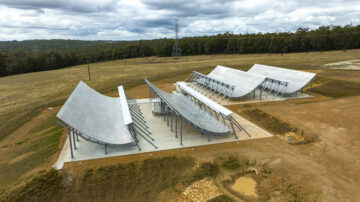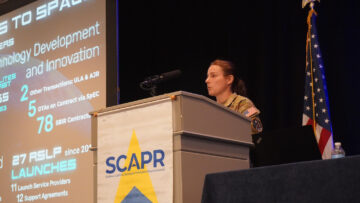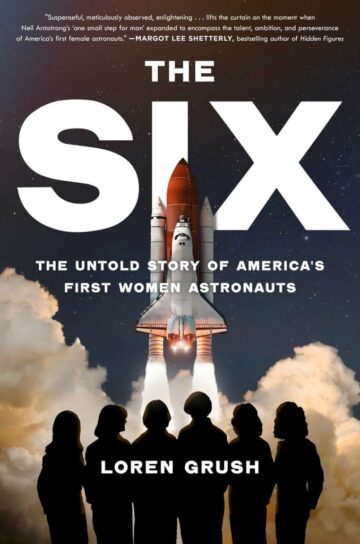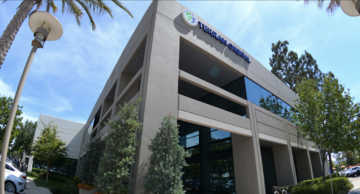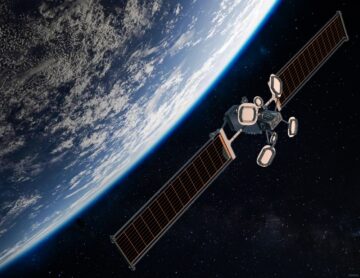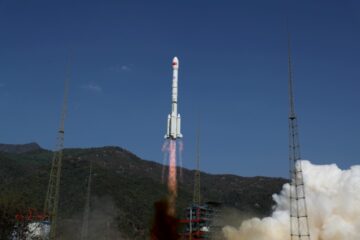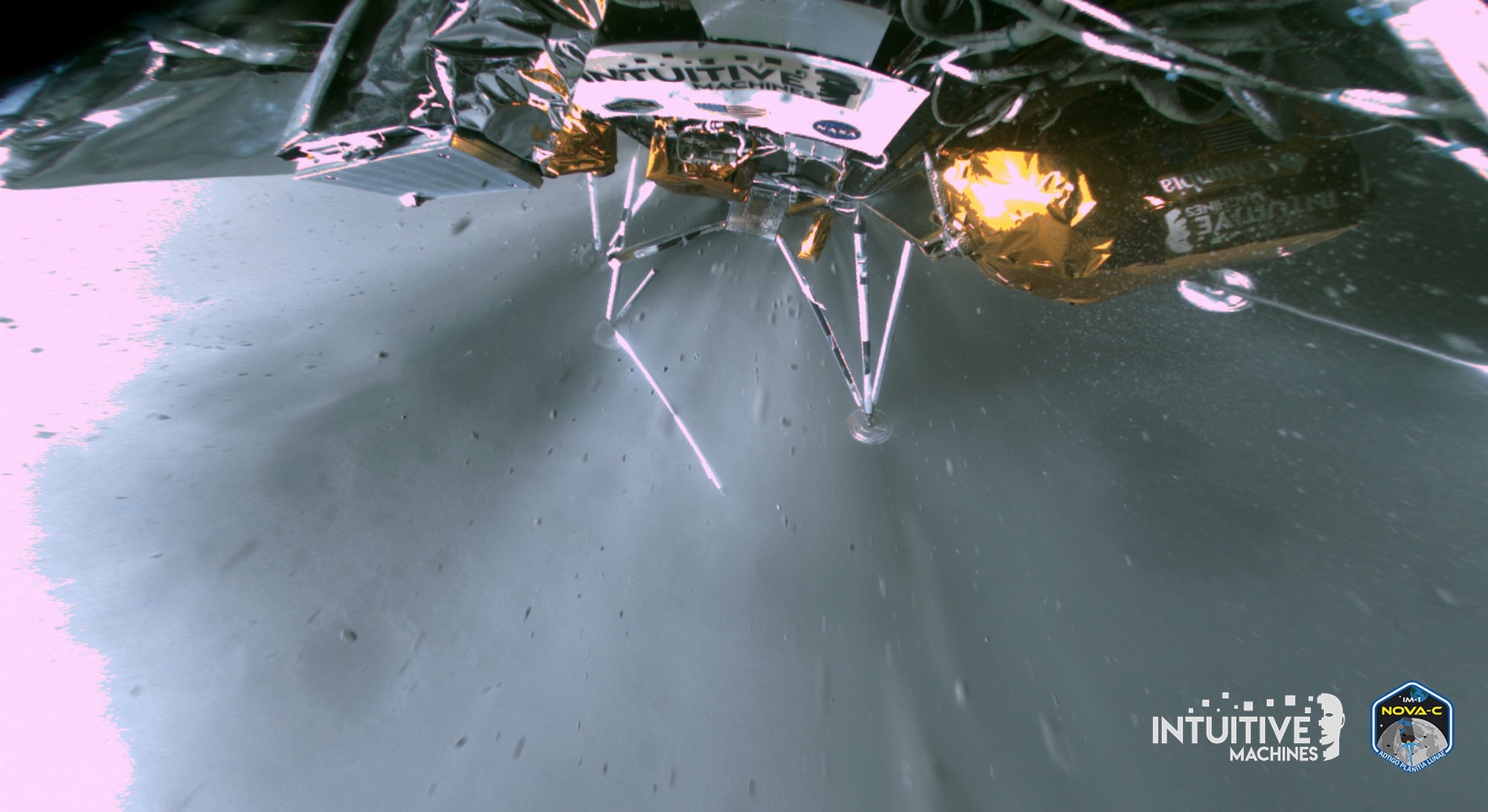
WASHINGTON — Intuitive Machines says it has identified several changes it will make to its Nova-C lunar lander ahead of its second mission late this year.
In a May 14 earnings call, Steve Altemus, chief executive of Intuitive Machines, said the company will upgrade communications, tracking and landing systems based on the lessons from the company’s IM-1 mission in February, which landed but tipped over nearly on its side.
Those upgrades are based on an internal review of the performance of the IM-1 mission. “The review resulted in software and hardware advancements that we believe expand our technical capability to track our vehicle accurately in space and land with 20 times better precision on our next mission,” he said.
Other changes, he said, involve “technical adjustments” to communications with the lander and orbit determination. That includes changing the configuration of antennas on the lander to improve bandwidth and communications continuity, according to his presentation.
Those changes will be incorporated into the company’s second lander mission, IM-2, scheduled for launch late this year. “The technical improvements for IM-2 are vertically integrated capabilities within the company that we can perform with little or no impact on our intended quarter 4 2024 launch date or require any additional capital investment while we continue assembly of the flight vehicle.”
He didn’t elaborate on those changes, but his presentation noted “more robust test and verification processes” for the IM-2 lander. On the IM-1 mission, the company failed to disable a safety switch on a laser rangefinder on the lander before launch, which kept it from being used as intended during landing. Company executives said shortly after the landing that had the rangefinders been working, they believe they would have had a fully successful landing.
The company is also working on a third lander, IM-3, which it plans to launch in 2025. All three missions have NASA as an anchor customer though the agency’s Commercial Lunar Payload Services (CLPS) program.
With a gap in CLPS missions after IM-3, Altemus said that the company is planning to fly a fully commercial mission after IM-3. “We have signed contracts with multiple payloads that we have been aggregating and holding,” he said, with enough in place to allow the company to proceed with a commercial mission as it continues to sign up additional customers for it.
Flying the mission, he said, would also allow the company to maintain a cadence of lunar lander missions between IM-3 and the next potential CLPS mission, a task order to be awarded by NASA later this quarter for launch in 2027.
Intuitive Machines touted other avenues for growth, such as winning one of three NASA Lunar Terrain Vehicle Services study contracts in April, a first phase that could lead to a potentially much larger award to develop a lunar rover for future Artemis missions. The company is also awaiting a potential award from NASA for its Near Space Network Services program, where the agency will procure communications services for missions on and around the moon.
Altemus added that the company plans to submit a proposal to NASA for industry studies for a revised Mars Sample Return program that could bring back samples cached by the Perseverance rover faster and less expensively than the agency’s own baseline plan. “Intuitive Machines has engaged the agency and intends to provide a solution set based on a technology architecture we have been developing for lunar material return,” he said, without elaborating.
The company reported $73.1 million of revenue in the quarter, far higher than the $18.2 million in the same quarter a year ago. The majority of that revenue, more than $40 million, came from the company’s OMES III engineering services contract it has with NASA in the first full quarter of that contract, said Steve Vontur, acting chief financial officer.
Intuitive Machines had a net loss of $5.4 million in the quarter, an improvement on the $14 million loss in the first quarter of 2023. The company had a cash balance of $55.2 million as of the end of the quarter, which Vontur said would be sufficient for the company through the rest of the year. The company is forecasting revenues of between $200 million and $240 million for 2024.
- SEO Powered Content & PR Distribution. Get Amplified Today.
- PlatoData.Network Vertical Generative Ai. Empower Yourself. Access Here.
- PlatoAiStream. Web3 Intelligence. Knowledge Amplified. Access Here.
- PlatoESG. Carbon, CleanTech, Energy, Environment, Solar, Waste Management. Access Here.
- PlatoHealth. Biotech and Clinical Trials Intelligence. Access Here.
- Source: https://spacenews.com/intuitive-machines-making-upgrades-to-second-lunar-lander/
- :has
- :is
- :where
- $UP
- 1
- 14
- 2%
- 20
- 2023
- 2024
- 2025
- 4
- a
- According
- accurately
- acting
- added
- Additional
- advancements
- After
- agency
- aggregating
- ago
- ahead
- All
- allow
- also
- an
- Anchor
- and
- any
- April
- architecture
- ARE
- around
- Artemis
- AS
- Assembly
- avenues
- awaiting
- award
- awarded
- back
- Balance
- Bandwidth
- based
- Baseline
- BE
- been
- before
- being
- believe
- Better
- between
- bring
- but
- by
- Cadence
- call
- came
- CAN
- capabilities
- capability
- capital
- Cash
- Changes
- changing
- chief
- Chief Executive
- chief financial officer
- commercial
- Communications
- communications services
- company
- Company’s
- Configuration
- continue
- continues
- continuity
- contract
- contracts
- could
- customer
- Customers
- Date
- determination
- develop
- developing
- during
- Earnings
- earnings call
- Elaborate
- end
- engaged
- Engineering
- enough
- executive
- executives
- Expand
- Failed
- far
- faster
- February
- financial
- First
- flight
- For
- from
- full
- fully
- future
- gap
- Growth
- had
- Hardware
- Have
- he
- higher
- his
- holding
- HTTPS
- identified
- iii
- Impact
- improve
- improvement
- improvements
- in
- includes
- Incorporated
- industry
- integrated
- intended
- intends
- internal
- into
- intuitive
- investment
- involve
- IT
- ITS
- jpg
- kept
- Land
- landing
- larger
- laser
- Late
- later
- launch
- lead
- less
- Lessons
- little
- loss
- Lunar
- lunar lander
- Machines
- maintain
- Majority
- make
- Making
- mars
- material
- May..
- million
- Mission
- missions
- Moon
- more
- much
- multiple
- Nasa
- Near
- nearly
- net
- network
- next
- no
- noted
- of
- Officer
- on
- ONE
- or
- Orbit
- order
- Other
- our
- over
- own
- perform
- performance
- perseverance
- perseverance rover
- phase
- Place
- plan
- planning
- plans
- plato
- Plato Data Intelligence
- PlatoData
- potential
- potentially
- Precision
- presentation
- proceed
- procure
- Program
- proposal
- provide
- Quarter
- Reported
- require
- REST
- resulted
- return
- revenue
- revenues
- review
- robust
- rover
- Safety
- Said
- same
- sample
- says
- scheduled
- Second
- Services
- set
- several
- Shortly
- side
- sign
- signed
- Software
- solution
- Space
- Steve
- studies
- Study
- submit
- successful
- such
- sufficient
- Switch
- Systems
- Task
- Technical
- Technology
- terrain
- test
- than
- that
- The
- they
- Third
- this
- this year
- those
- though?
- three
- Through
- times
- to
- touted
- track
- Tracking
- upgrade
- upgrades
- used
- vehicle
- Verification
- vertically
- we
- which
- while
- will
- with
- within
- without
- working
- would
- year
- zephyrnet

